Osaka: a Japanese Microcosm
- Aaron Schorr

- Mar 6, 2020
- 14 min read
We left Kyoto for Osaka, where we would be spending the rest of our nights in Japan. Both cities are located in the Kansai Region (historically also known as the amusingly-named Kinki Region), the cultural heart of Japan located in the western part of Honshū Island. More specifically, both cities, along with the city of Kobe further to the west, form the Keihanshin Metropolis, home to nearly 20 million people with a GDP matching Greater London. Compared to Tokyo, that feels positively quaint, but Osaka, the nexus of the metropolitan area, is undoubtedly a player in the global big-city league and draws lots of parallels with the capital.
The basin Kyoto lies in is connected to Osaka's coastal plain by a relatively narrow strip of land around the confluence of the Katsura, Uji, and Kizu Rivers, which forms a natural bottleneck for traffic between the two. Few other places are such tangible examples of the incredible investment in infrastructure which has supported the intense development Japan has undergone. Besides an elevated motorway, four different types of rail pass through this strip - the competing Tōkaidō, Keihan, and Hankyu Main Lines providing commuter service between Kyoto and Osaka on different routes and the Tōkaidō Shinkansen linking Tokyo with Nagoya, Kyoto, and Osaka which I discussed in the previous post. The numbers of people who pass here every day are astounding, yet traffic and unpredictable commute times are not problems residents of the Kansai Region regularly face.

Castles and Clubs: Osaka by Day and Night
Coming out of Yodoyabashi Station in downtown Osaka, there could be no doubt we were not in Kyoto anymore. The temples were replaced by shiny skyscrapers, the futuristic cityscape crisscrossed with elevated highways. The rail system, as we would soon discover, was essentially a smaller version of Tokyo's, with 8 subway lines, a tram line, and over two dozen suburban and commuter rail lines serving over 1,100 stations across the Kansai region and carrying nearly 15 million passengers a day.

We dropped our bags off and set off on foot across town to Ōsaka-jō, Osaka's historical castle, which is one of Japan's most iconic cultural symbols. The walk took us through Chūō-ku (literally, "center district"), a major business center, and the streets were clogged with suited office workers leaving their high-rise buildings for lunch.

The glass and steel construction came to an abrupt end as we reached the castle, surrounded by high walls and a moat. The castle was built in the late 16th century by Toyotomi Hideyoshi, a local samurai who is regarded as a national hero in Japan after successfully unifying the Japanese archipelago under his rule. One of the floors in the castle is entirely devoted to an exhibit about his life, in rather glorifying language if the Japanese translated by my phone was anything to go by.

Like any good castle, Ōsaka-jō was conquered and burnt down several times in the succeeding centuries, including by Imperial forces during the Meiji Restoration in 1868, after which it became a major arms factory through World War II. Repeated American bombing raids targeted the castle, nearly leveling it in August 1945.
The main tower was renovated in the 1990s. The result is a strange hybrid, the exterior a concrete replica of the original tower and the interior a modern museum, unlike most European castles which attempt to showcase living conditions in a castle. The top floor had panoramic views of the city, highlighting the sharp contrast between old and new that had come to define Japan in my mind.

One of the specialties of Kansai cuisine is okonomiyaki, savory pancakes filled with cabbage and usually meat or seafood. We had dinner in a restaurant specializing in the dish, with a gas-lit griddle called a teppan in the center of each table. The okonomiyaki are brought to the table mostly cooked and placed on the griddle; the customers remove them with small spatulas when they're cooked to their liking and add mayonnaise, a sauce very similar to barbeque sauce, and katsuobushi, dried tuna flakes. It was a lot to figure out at first, but nothing the internet couldn't help with.

Osaka was supposed to have some of the best nightlife in Japan, and our expectations were sky-high after our experiences in Tokyo. We got some umeshu at a liquor store in Umeda, a major business district full of high-end clubs (in the British sense of the word), and prepared for the night ahead in our unusually social hostel (by Japanese standards, that is). Our venue of choice was Piccadilly, a club that boasted an impressive lineup of world-class DJs who had performed at it over the past couple years. It was actually too international for my taste, with rather banal music and large groups of snobby Westerners. Everything about these people screamed "children of wealthy expats", down to the Japanese chaperones keeping an eye on them from a respectful distance. Our hostel was thankfully walking distance from the club, so we didn't have to wait for the subway in the morning and could leave at the much more reasonable hour of 2:30 am.
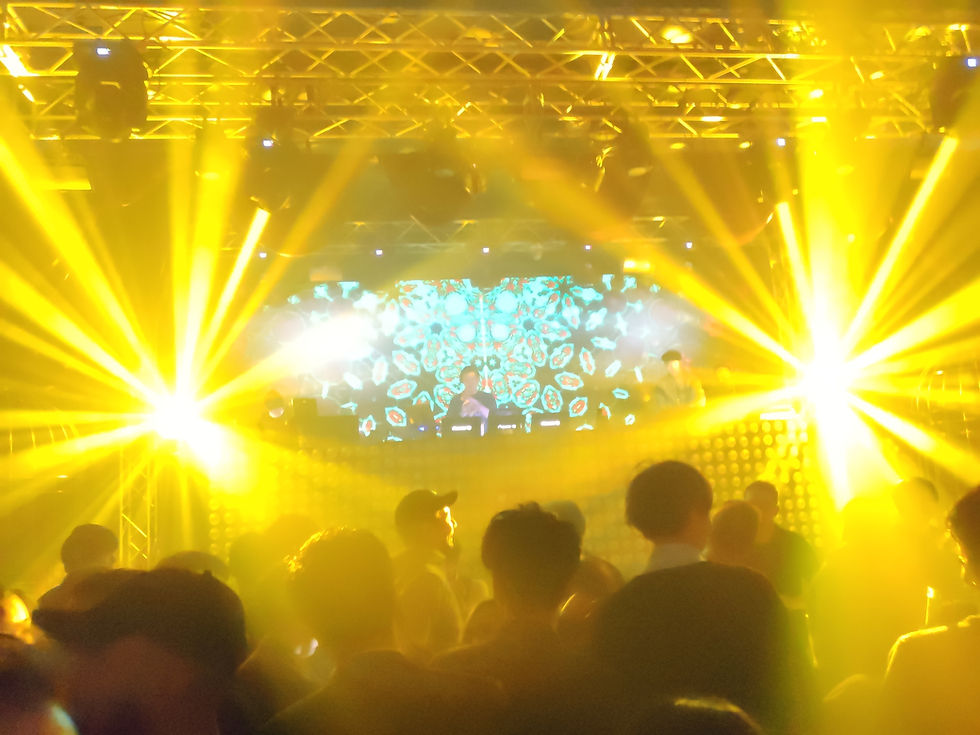
Underground Cities and 11-Story Arcades
In a repeat of events in Tokyo, the housekeeper entered our room at 10 am, saw us in bed, and still decided this was the perfect time for some vacuuming. Two times out of two was a pattern; I don't know what they teach cleaning staff in Japan, but they should probably start with "letting guests sleep is more important than getting rid of some imaginary dust". After failing to fall back asleep, we decided to give Japanese curry a try. We tried three different places, but for some unknown reason each one was closed. It had started to rain quite hard, so we cut our losses and ducked into the first affordable place we saw, which turned out to be a great grill restaurant hidden underground.
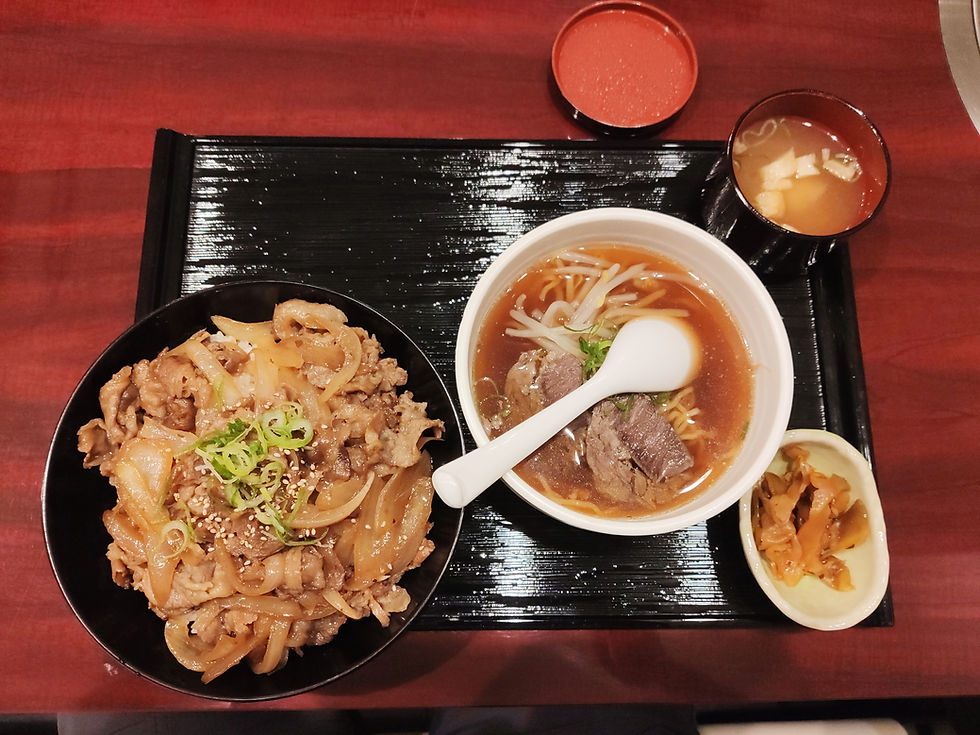
The rain killed any chance of outdoor activities and the government had decided to shut down all the museums as a preventative measure against the spreading coronavirus. A Google search revealed that Osaka was home to one of the largest arcade complexes in the world, which sounded perfect for a rainy afternoon. Also perfect in rainy weather are the massive underground complexes that surround major train stations in Japan, and Osaka's largest stations Umeda and Namba are some of the largest we saw. Both are not so much train stations as small cities, constructed with arms connecting stations of different subway and commuter rail lines and radiating out along the surrounding avenues for hundreds of meters. Descending one of the dozens of staircases at street level or in a nearby building, you find yourself in a parallel world, with shopping malls, barber shops, and some of the best food in the city, ranging from ramen stalls to gourmet food department stores. Train stations in most of the world are seedy, smelly places which only serve their narrow purpose; in Japan, they're clean, convenient, and serve many more functions beyond transportation. The arcade was the better part of a kilometer from the subway platform but the tunnels took us the whole way there, warm and dry.
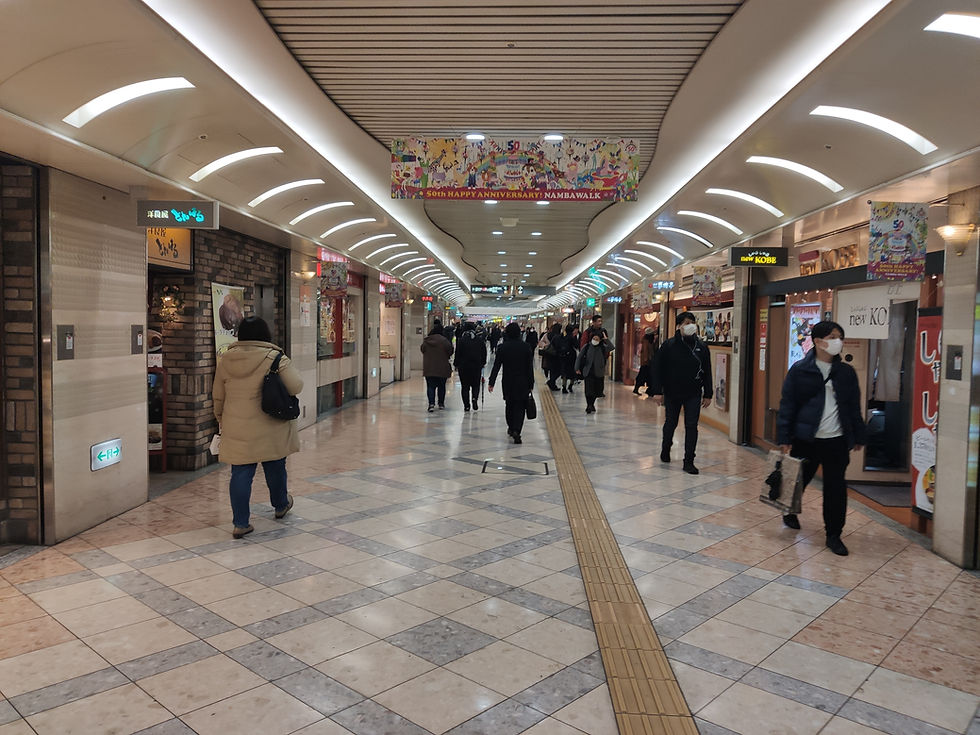
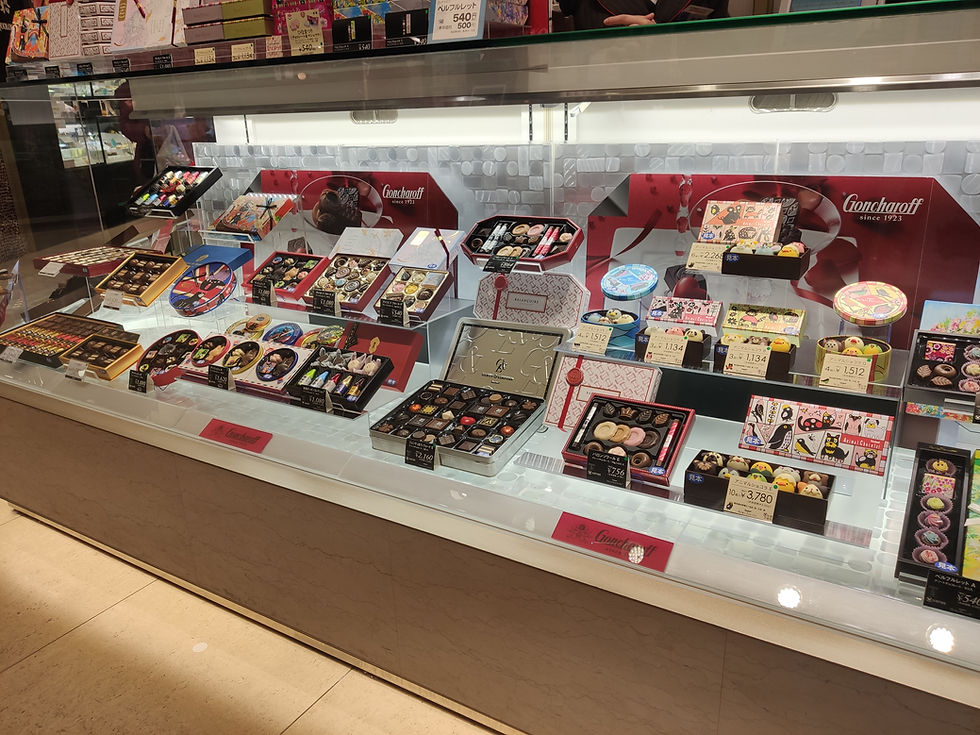
Stepping into the 11-story building was like going back to Akihabara. The bottom three floors were crammed full of slot machines, claw cranes, and arcade games in a cacophony of electronic sounds and flashing lights. Young men were clustered around the machines, feeding 100-yen coins in as quickly as they could. Further upstairs was the "spo-cha" (sports challenge) complex, paid for by the hour. There was an archery range, a rollerskating arena, trampolines, batting cages, and other sports facilities with strong arcade elements spread over three floors.

The fourth floor was devoted to free-access video games, entirely Japanese and hopelessly addicting. We played racing games against each other, the adrenaline pumping harder than in the sports facilities with trance music blaring directly into our ears. After visiting Tokyo and Osaka, I finally understood why all Japanese racing games looked strange in the same way - they were imitating the elevated highways that are a fixture of Japanese cities but foreign to Westerners. Other games were types I had never played before, like a game with 8 buttons arranged in a circle you have to press in precise sequences matching the beat of Japanese pop songs. Thank you, rain gods, for this unique experience.

After another uniquely Japanese experience watching movies in virtual reality, we finally got our curry fix at a place downtown that had clearly missed the memo the others received. Namba, the area we were in, totally felt like Tokyo, with bright neon lights everywhere and touristy shopping streets, but the rain cut our exploration short.

Kobe: Forests, Funiculars, but No Beef
We set off the next morning towards Kobe, a city of 1.5 million further west on Osaka Bay. I had the chance to stand behind the conductor, the first female one I'd seen in Japan, and watch her work. At the center of the instrument console was an analog watch, a fixture of JR trains across the country. At each station and at multiple points along the route, the conductor would compare the time displayed by the watch with the time on the printed scheduled, tracing the correct line with her finger to eliminate confusion. For each stop, the schedule had arrival and departure times printed in 5-second increments, and we didn't deviate from them even once. One of the ways JR achieves this level of punctuality is by using two-man crews, a conductor operating the train and an assistant in the rear, who handles the doors and PA announcements. Thus the conductor can focus exclusively on running on time, waiting for the all-clear signal from the rear to depart the station with military precision.
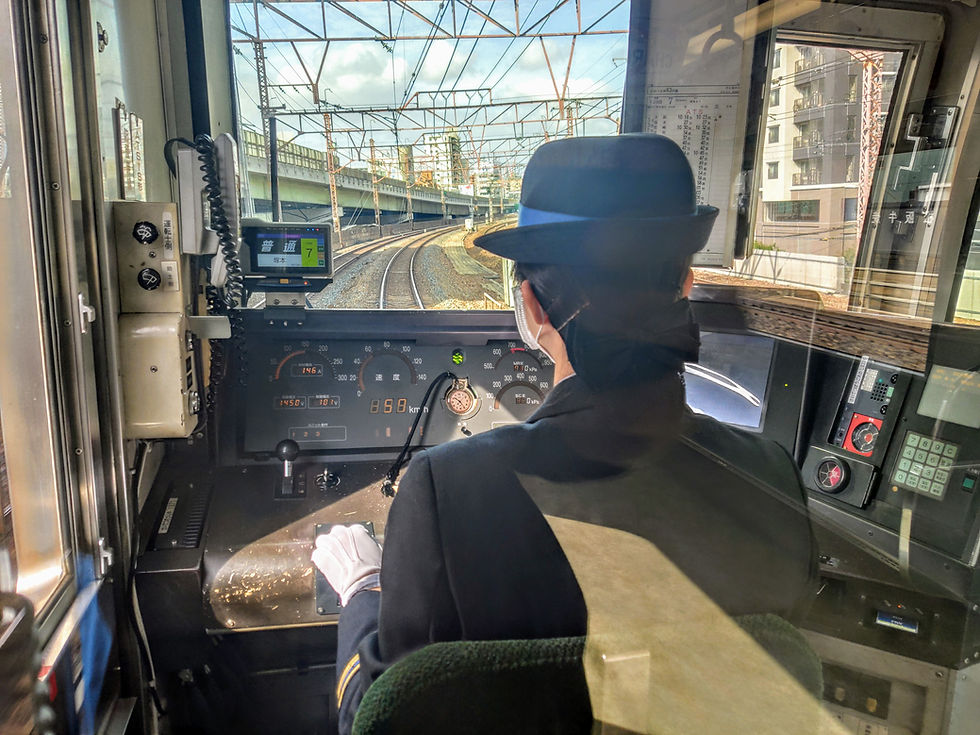
Having received my daily rail education, we got off the train and took a funicular up Rokkō, a mountainous spine forming Kōbe's natural northern border. The top had botanical gardens, an "international music box museum", and a golf course, connected with pleasant hiking trails. We hiked up to a viewing platform at 850m above sea level, with views of the Keihanshin metropolis and Osaka Bay.

With the elevation came appreciation of yet another of Japan's feats of engineering. Look at a map of Osaka Bay and you'll see it's ringed with several dozen islands with exceedingly straight outlines. This is not due to unique geography, but rather to a decades-long process of reclaiming land from the sea, using dirt from construction sites to create more land in the bustling metropolis. Both Kobe and Osaka have airports built on two such islands; others contain shipping and logistics facilities for the Port of Osaka, oil refineries, factories, and even residential neighborhoods. Beneath us, two islands under construction were visible, the concrete perimeter walls not quite filled with earth yet.

After savoring the views, we completed a circuit of the mountaintop. The music box museum, like every other museum in the country, was sadly closed and the botanical gardens looked rather sad in their end-of-winter state, but the forest trails were pleasant and the weather was perfect, the previous day's rains fine without a trace. The sun was shining and the paths were full of primarily middle-aged Japanese out for whatever the local version of a Sonntagnachmittagspaziergang was called.
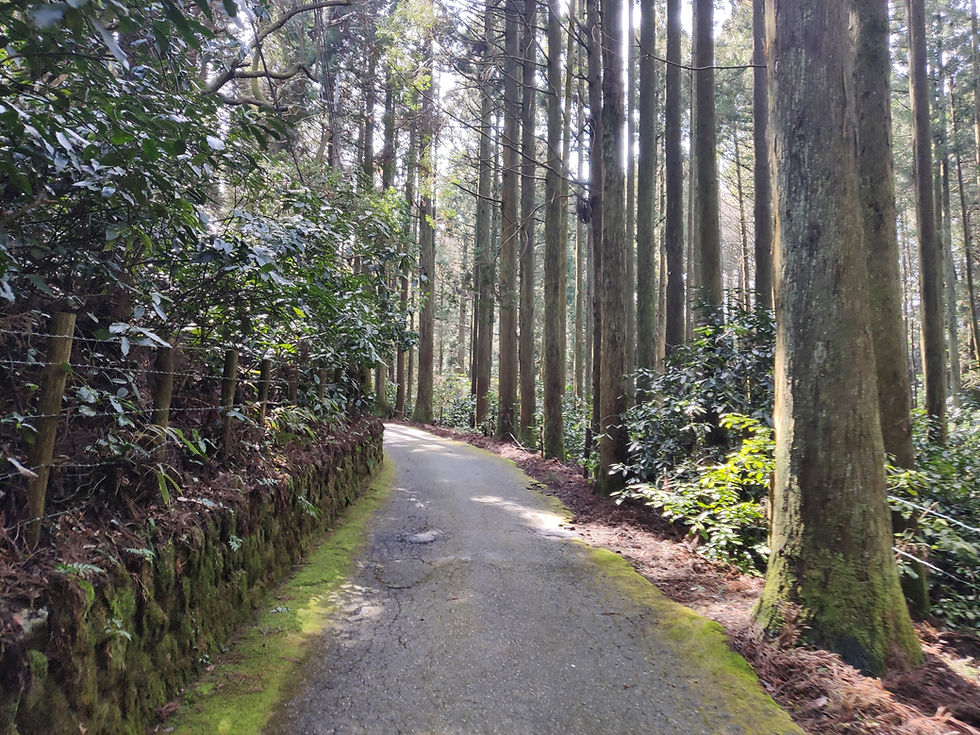
Electrocuting Baths and Creative Prostitution
We returned to Osaka after lunch in a Chinese-style cafeteria in downtown Kobe. I had really wanted to try Kobe beef, regarded by many foodies as the best beef in the world, but the prices starting at $50 for a small steak convinced me to leave it for my next trip.
A visit to a public onsen not far from the main train station was the perfect way to relax our muscles after the day's climbing, and this onsen was even better than the one in Odawara. Past the strange woman keeping an eye on both sides of the bath (whom I suspect is a fixture of Japanese public baths), there were three indoor baths - freezing, boiling, and soup-on-an-open-flame temperature - and an outdoor one with tepid purple water.
The hot bath contained a small area separated from the rest of the bath which intrigued me and I swam in to investigate. I immediately felt tremors in my entire body and thought it was dehydration from the hot water. Looking underwater, there were two metal walls which produced an electric current in the water between them, ranging from mildly unpleasant in the middle to powerful spasm-inducing near the walls. The expression on my face must have been something to behold, since the Japanese man sitting across from me started laughing, a rare and welcome break from the strict politeness I was accustomed to.

All this male nudity brings me to the slightly sensitive topic of Japanese sex culture. To me, sex is one of the most interesting aspects of contemporary Japanese society. Pornography and prostitution are both illegal, yet widespread and highly profitable industries, making money through exploiting legal loopholes. In the case of pornography, strategically-placed pixelation ensures the material isn't legally classified as "indecent"; in that of prostitution things start to get really creative. Since Japanese law only prohibits paying for intercourse between unacquainted people, three ways around the rule have emerged: paying for other sexual services, paying an "entry fee" to a facility such as a bathhouse or "compensated dating", where the two parties become "acquainted" before clothes start coming off. We were offered multiple such services in Tokyo, Osaka, and even Kyoto, the legal tolerance of the adapted sex industry removing the need for discretion, with establishments operating on the main streets and looking anything but seedy.
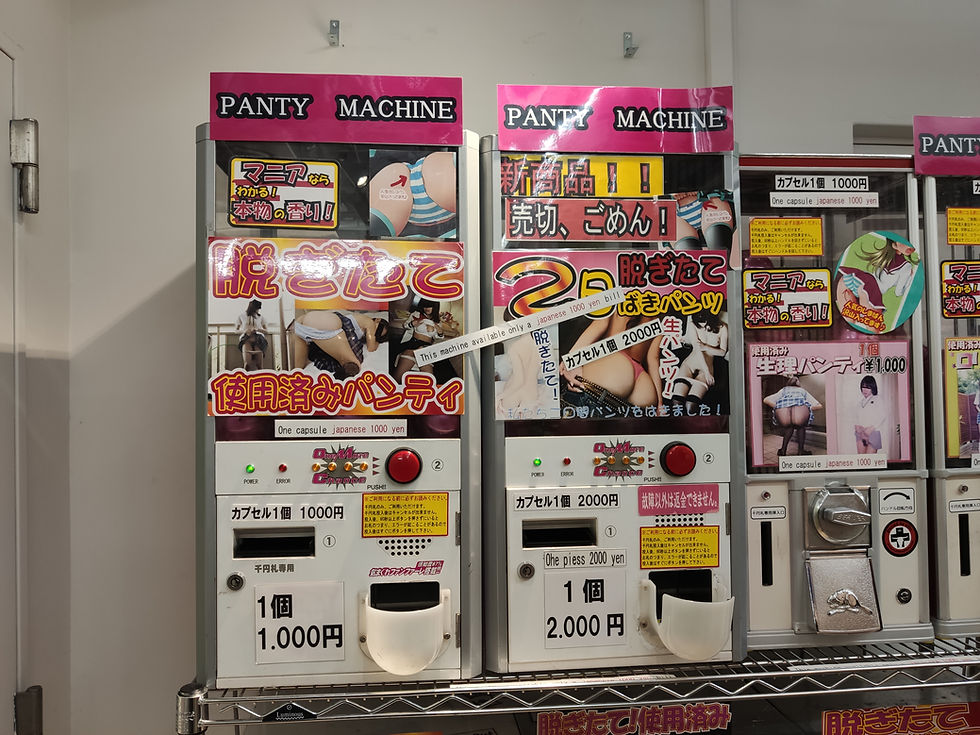
The Japanese adult film industry is one of the largest in the world, best known for its outlandish content, as most Internet users within certain demographics know. The country has a long pornographic history, with Japanese shunga, or erotic paintings, dating all the way back to the 8th century CE. Oiran, or high-class "women of pleasure", were long a fixture of Japanese society, similar to geishas (female companions) but offering a broader range of services. These days, things are rather different, with phenomonons such as sōshokukeidanshi (“herbivore men”), who actively refrain from sexual relationships, ever-growing numbers of young people who say they "despise" sex, and a "virginity crisis" extensively reported and examined in the West.
It's surprising then that everyday life in Japan is so sexualized. Besides the moe culture I wrote about in Tokyo, cartoonish depictions of anatomically-impossible women are everywhere, including the famous manga comic books office workers line up to read in convenience stores during their lunch breaks. A possible explanation for this dissonance is the prevalence of technological sexual stimulants not requiring human interaction, such as virtual-reality pornography and sex robots. Nearly unthinkable in the West, these are normal fixtures of life in Japan, with shops proudly advertising their wares in the downtowns of major cities.
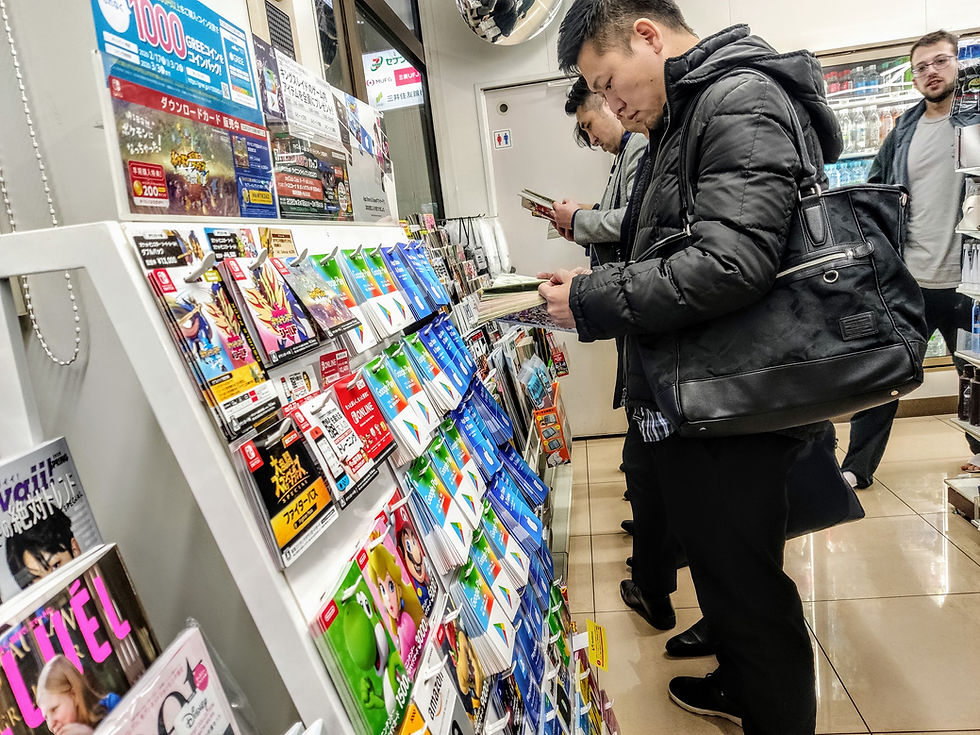
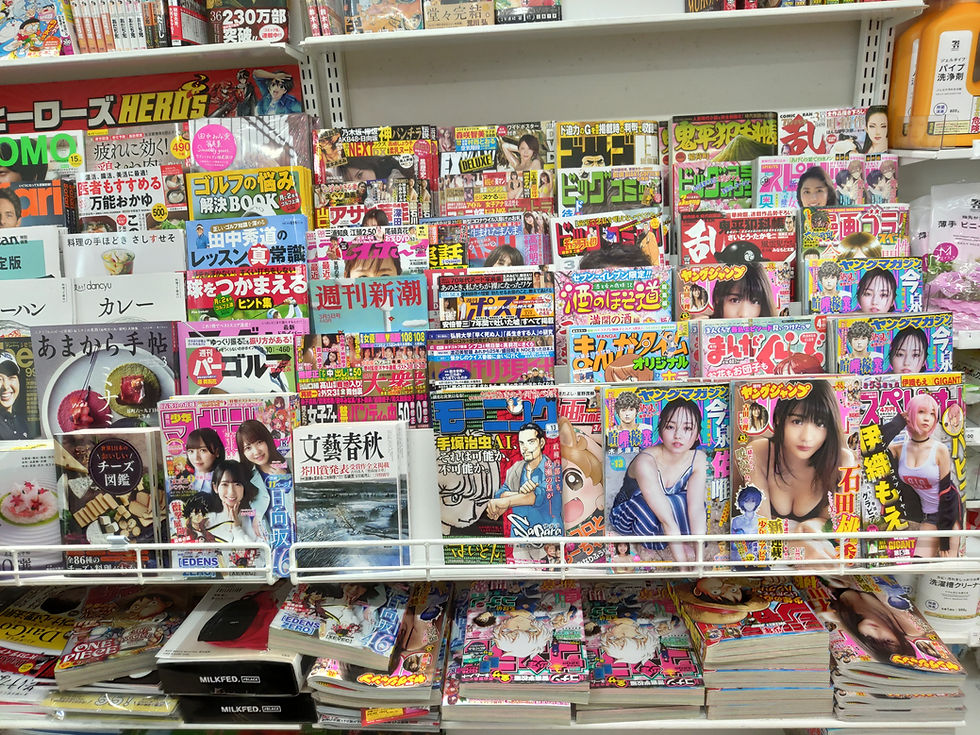
Tacky Shrines and Inedible Candy
Back in reality, we left the onsen completely drained, feeling like we were walking on clouds. Our favorite food in Japan had been ramen from the first restaurant we had visited by chance in Tokyo, which we later discovered was part of a large chain called Ichiran. In search of some culinary closure, we had our last dinner at one of their Osaka branches, the fourth branch we had visited in two weeks.
After breakfast at a strangely regal café run by a kind old man, Roy and Peleg parted ways with us to catch a flight to Bangkok. Yotam and I headed south to the Namba Yasaka Shrine, a very bizzare shrine shaped like a lion's head (to me it looked like a dragon, but apples to apples) built in 1974. I was again baffled at how a people as educated and developed as the Japanese could worship a concrete lion's head with fake gold teeth, offering it incense, money, and food.


Japanese cities have an incredible density of convenience stores, nearly all of which are owned by 7-Eleven, FamilyMart, or Lawson. These stores are every traveler's dream, open 24/7 and selling drinks, snacks, groceries, and even cooked food at reasonable prices (by local standards). Convenience stores had become a major fixture of our trip to Japan, with some days bringing nearly a dozen visits to different stores. We would go for cereal and milk in the morning, snacks and onigiri (rice balls with fish) between sights, sake and shōchū in the evening, and late-night munchies after going out. Automatic doors in Japan seemingly can't open and close without playing cartoon music, and the sounds I most associate with Japan at this point are the jingles played by subway and convenience store doors, usually accompanied by a high-pitched "konnichiwa" in the case of the latter (the Japanese concept of customer service involves speaking in an overly chipper child-like voice; most train announcements sound like adult women pretending to be eight year olds on laughing gas).

Our fixation with convenience stores was such that I realized I hadn't visited a single supermarket since arriving in Japan. There was a supermarket down the street from the shrine and we walked down every aisle, looking for weird Japanese products. Never before have I seen so many kinds of seafood, including whole octopus legs and parts of squid I only identified with the help of Google Translate. Japan has serious love for anko, red bean paste, which was another recurring product. We got a bag of assorted anko-filled sweets and some anko sucking candies; most of the sweets were fine, but the sucking candies were horrific and ended up in the garbage of the next FamilyMart we visited.

Japan's Lowest Mountain
We paid a quick visit to Shinsekai, Osaka's historic shopping district with a distinctive tower in the center of it. Besides a very bizzare souvenir shop selling lots of Japanese snacks and anime-themed products, there wasn't much to see in daylight. The whole place is apparently lit up rather impressively at night, but I'll have to wait for the next trip to find out.

I wanted to see some of the artificial islands up close, so we took a subway out to Kaiyukan, an artificial island located at the mouth of the Aji River. Alighting in the middle of Minato-Ku (Harbor Ward) was like stepping into a futuristic yet somewhat dystopian world. There were elevated highways in every direction, leading to gargantuan bridges connecting the different islands around the bay. One of these is the Minato Bridge, the third-longest cantilever truss bridge in the world, which looks like it belongs on a much larger body of water. Warehouses were interspersed with cheerless apartment towers, with a cruise ship terminal, a Ferris wheel and an aquarium taking up the northern part of the island.
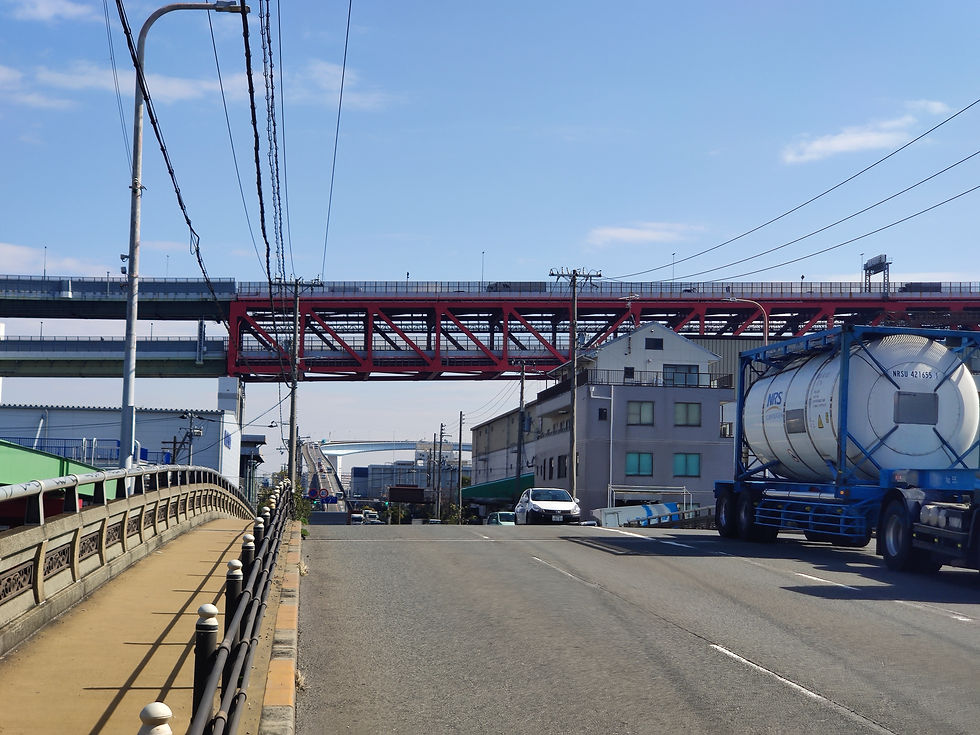
It was a strange place, blending tourist attractions, an industrial port, and residential buildings, made even stranger by a replica of the famous mermaid statue from Copenhagen overlooking a coal depot, apparently a gift from Carlsberg to the city. To top it off, the island was home to Tenpōzan, a grassy rise bearing the absurd title of Japan's lowest mountain, coming in at 4.53 meters above sea level.

One of Osaka's culinary favorites is a chain of restaurants selling butaman and gyoza, Chinese-style steamed buns and fried dumplings. The main station has no fewer than four different places owned by the chain, each one busier than the next, ranging from a takeout stall near the commuter rail platforms to a sit-down restaurant in a food court further out. We got some of each and returned to the hostel to pick up our bags.
Our ride to the airport was supposed to involve a simple change from the subway to the airport express at Namba Station, which ended up being a 15-minute trek through a solid kilometer of some of the thickest rush-hour human throngs I've ever seen. This was to be my last experience of the madness that is Japanese train stations, which put every other place I've been to shame in terms of busyness and efficiency.

The departures board at the airport had nearly as many cancelled flights as scheduled ones, mostly to China and South Korea. Our flight was delayed by close to there hours due to an unspecified mechanical issue, giving me plenty of time to reflect on my time in Japan. Every aspect of the trip had been unplanned - it had started as a joke idea in Hoi An nearly a month ago, gradually gaining seriousness as the situation in China worsened. If a year ago, after a day of skiing in Andorra someone would have said that in exactly a year's time I would find myself naked in a Japanese bathhouse with nearly the same group of people I would have laughed in their face. Japan had never been in the cards for this trip, and the reality of being there with three friends was so absurd I could have hardly dreamt it.
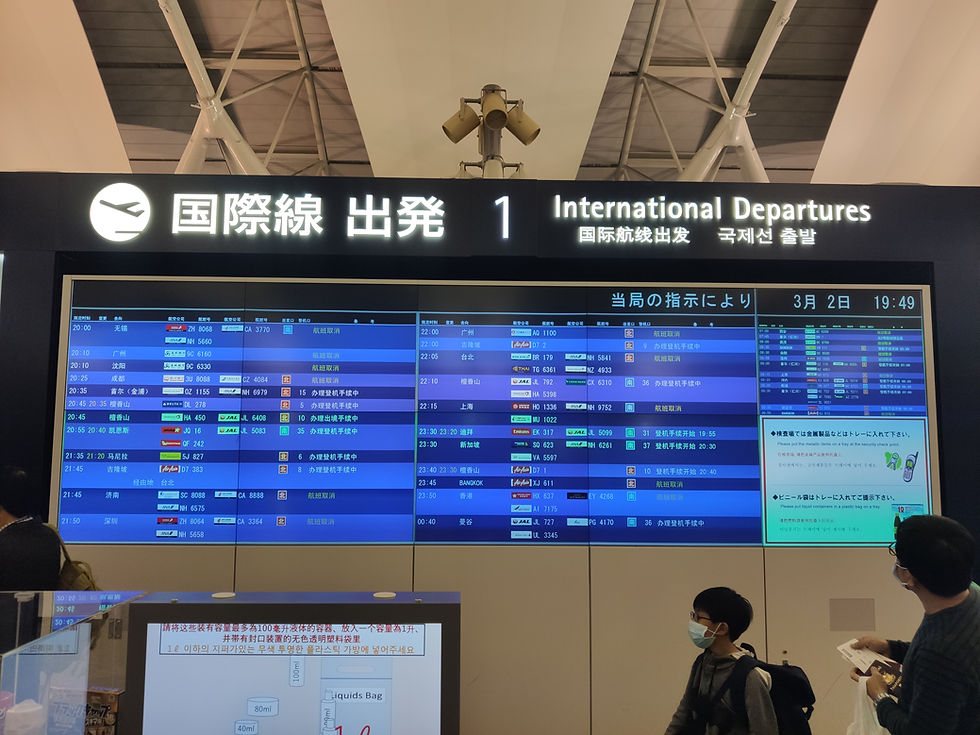
My visit to Japan had been amazing fun and had exceeded my expectations in many ways. I would have liked to stay much longer, but Hokkaido, where I would have liked to go next, was suffering from a serious viral outbreak and seemed like a place to avoid at the moment. Besides, being in Japan was expensive, more expensive than anywhere else I had traveled on my own budget. To be fair, it wasn't as expensive as many travelers like to make it out, but it was definitely a challenging place to go on a budget, and the contrast coming from backpacker-paradise Vietnam didn't make it any easier.
You get what you pay for, though, and nowhere was this as obvious as in Japan. Public spaces were squeaky clean, everything ran on time, and the hostels were significantly nicer than similarly-priced ones in Europe. An example of this was the glorious Japanese toilets that could be found nearly everywhere, with heated seats, built-in bidets, and often even automatic flushing. It may sound ridiculous, but don't knock it until you try it. I had no doubt I would be back in Japan to experience more of what this unique country had to offer.
ありがとう、日本!Thank you, Japan!






Comentarios